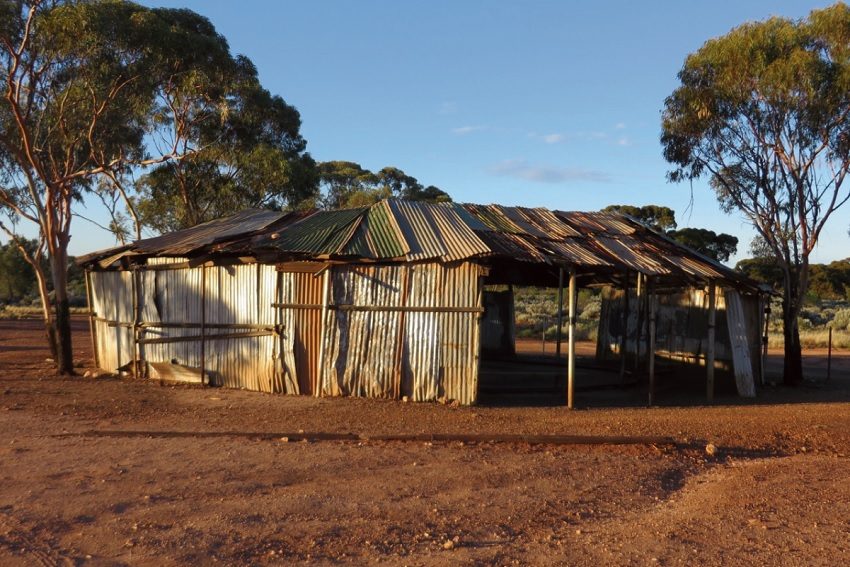Art Free Zone: Out West and Against the Odds

Every year, John Neylon travels inland to find art in the strangest places. This year, he heads far west.
Every Sunday afternoon the old two-up ring near Kalgoorlie fires up. Punters back the odds. The ringer spins the coins. Money is won or lost. Then everyone goes home and the shed is left to its thoughts.
It’s not much of a structure — virtually an open-roof circle made from rusted corrugated iron held together by scraps of timber and bits of wire. It’s a poor man’s Globe Theatre, a ramshackle stage on which the kind of passions and dreams that searching for gold inspires, play their parts. In late afternoon light it has a haunting presence. It speaks of a century-old dream of gambling and hard yakka being rewarded in an instant when ‘heads it is’ or when a gold-bearing rock was dislodged by a horse’s hoof.
On an annual road pilgrimage to escape the vanilla-sky routines of an over-familiar art world this structure was a reminder that the most rudimentary of forms, sited in the most ‘non-art’ of places can sometimes speak to the imagination in ways conventional art works can only envy. This realisation happened elsewhere on the road — a sudden ‘coming-upon’ what can best be described as a roadside shrine out of Mount Tom Price. Why this place? Why so many cairns of rocks, many bearing heartfelt messages of grief, entreaty or remembrance — who knows? This was not a place to camp. Too many ghosts. So too a place called Deep Gorge on the Burrup Peninsula.
It’s a site rich in ancient petroglyphs — the world’s largest array of such treasures. As the late sunlight begins to rake over the rock surfaces, images of creatures, plants and people, and other emblematic forms, insinuate themselves into view. What a perspective on contemporary life this site offers — but not for all the feel-good reasons such as artefacts demonstrating long-term occupancy and so on. Because various Burrup Peninsula sites could not meet requirements within the Western Australian Aboriginal Heritage Act that a place be “devoted to religious use” protection was lifted and thousands of engravings destroyed. Some survivors have been herded into compounds for protection.
The spectacle of a flare stack of a nearby gas refinery looking down on the Gorge evokes a scene from War of the Worlds. Or, to make it sound artier, totally surreal. Consider what this means and then decide if your art needs to be made or deserves to live.

Antony Gormley, Inside Australia, Lake Ballard, 2017 (Photo: John Neylon)
At Lake Ballard, Antony Gormley’s skeletal humanoids set on the vast sweep of an ancient lake bed pass the test. This is art in extremis, heroic failure as intended, human presence stripped to the bone and compressed to stick figures of insignificance. When all the goldfield towns nearby have moved on, some to new-found prosperity and others to drive-through decline, perhaps this collusion between an Anglo imagination and a timeless land will endure to say ‘we once lived here — people like you’.
Further north, on the site of the old mining town of Gwalia, abandoned almost overnight in the 1960s, small, corrugated iron dwellings, not art, do the heavy lifting in keeping the human narrative alive. Like the clapboard movie-set facades of abandoned shops in old Western Australian mining towns, they croak and whisper of lives once led.

‘Mon Repose Hostel’, Hyden, 2017 (Photo: John Neylon)
To confess, one objective of this ‘art free zone’ road trip was to see if Fred Williams nailed it when he went to the Pilbara in 1979 and subsequently produced the masterly Pilbara series of paintings in the early 1980s. Of course he did. The opalescent colours are still there. The mulberry red slashes of red escarpments set against pelts of creamy green-white spinifex — he captured it all.
Williams once said that he was trying to picture the landscape “with the skin off” – which explains his reduction of key aspects of topography to incisive marks and washes of pigment. And everyone but everyone has observed how he flattened space and in doing so invited the viewer to consider this or that ‘landscape’ is as much a known or imagined space as a view. But times and contexts change. Some may choose to view this body of work through the lens of the Pilbara series as an informal commission arrangement with CRA Ltd, the company operating the Pilbara mines at the time and tensions between mining, Aboriginal and other activist groups regarding mining leases on Aboriginal reserves.
The soft diplomacy of art takes many twists and turns. In the West it is almost impossible now to divorce anything, even art, from the seduction of buried treasure and dreams of unlimited development. Copper coins tossed by the spinner at the Kalgoorlie two-up ring elevate hopes for a few seconds. The massive haul trucks, each with a golf ball of gold buried in the load, take 30 minutes to reach the lip of Kalgoorlie’s Super Pit. But in the end it’s all the same. As local bush poet Tom ‘Crosscut’ Wilson had it, it’s all about the: ‘Ragged shirt and gleaming collar / Empty ‘kick’ and mighty dollar / Health, and wealth, and grief, and squalor.’ Hardly a place you’d expect to find art. Or is it?
Header image: Two up ring, Kalgoorlie, 2017 (Photo: John Neylon)